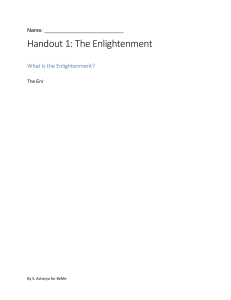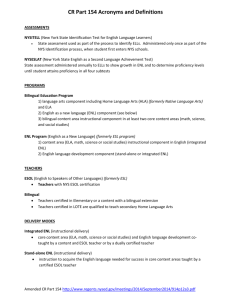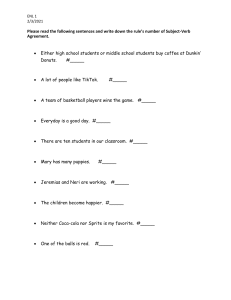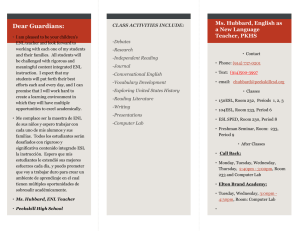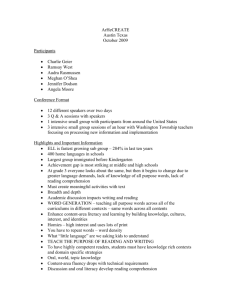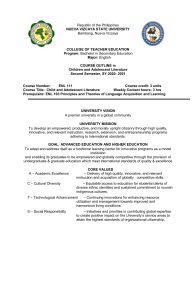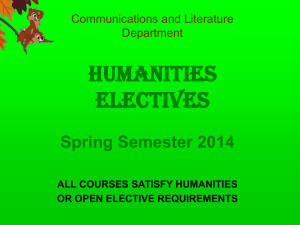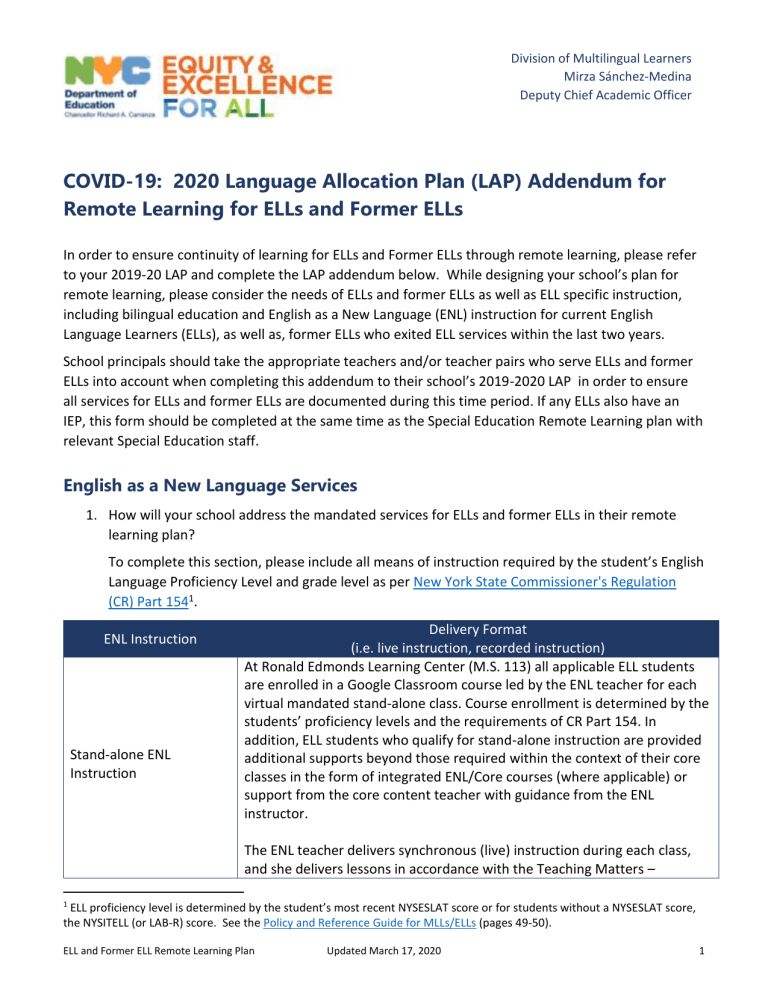
Division of Multilingual Learners Mirza Sánchez-Medina Deputy Chief Academic Officer COVID-19: 2020 Language Allocation Plan (LAP) Addendum for Remote Learning for ELLs and Former ELLs In order to ensure continuity of learning for ELLs and Former ELLs through remote learning, please refer to your 2019-20 LAP and complete the LAP addendum below. While designing your school’s plan for remote learning, please consider the needs of ELLs and former ELLs as well as ELL specific instruction, including bilingual education and English as a New Language (ENL) instruction for current English Language Learners (ELLs), as well as, former ELLs who exited ELL services within the last two years. School principals should take the appropriate teachers and/or teacher pairs who serve ELLs and former ELLs into account when completing this addendum to their school’s 2019-2020 LAP in order to ensure all services for ELLs and former ELLs are documented during this time period. If any ELLs also have an IEP, this form should be completed at the same time as the Special Education Remote Learning plan with relevant Special Education staff. English as a New Language Services 1. How will your school address the mandated services for ELLs and former ELLs in their remote learning plan? To complete this section, please include all means of instruction required by the student’s English Language Proficiency Level and grade level as per New York State Commissioner's Regulation (CR) Part 1541. ENL Instruction Stand-alone ENL Instruction Delivery Format (i.e. live instruction, recorded instruction) At Ronald Edmonds Learning Center (M.S. 113) all applicable ELL students are enrolled in a Google Classroom course led by the ENL teacher for each virtual mandated stand-alone class. Course enrollment is determined by the students’ proficiency levels and the requirements of CR Part 154. In addition, ELL students who qualify for stand-alone instruction are provided additional supports beyond those required within the context of their core classes in the form of integrated ENL/Core courses (where applicable) or support from the core content teacher with guidance from the ENL instructor. The ENL teacher delivers synchronous (live) instruction during each class, and she delivers lessons in accordance with the Teaching Matters – 1 ELL proficiency level is determined by the student’s most recent NYSESLAT score or for students without a NYSESLAT score, the NYSITELL (or LAB-R) score. See the Policy and Reference Guide for MLLs/ELLs (pages 49-50). ELL and Former ELL Remote Learning Plan Updated March 17, 2020 1 Division of Multilingual Learners Mirza Sánchez-Medina Deputy Chief Academic Officer ENL Instruction Delivery Format (i.e. live instruction, recorded instruction) Teaching at Home curriculum, which is available on the NYC DOE TeachHub. The ENL teacher crafts lessons for each proficiency level group based on the content contained in the curriculum and student proficiency levels. The scope and sequence of each curriculum is available below by grade level: 6th Grade 7th Grade 8th Grade The ENL teacher’s lessons include the following features (any given lesson may include several of those listed below): • Integrated content and language objectives (for stand-alone and integrated instruction) • Multiple media sources; including video, and web to represent abstract concepts • Embedded social-emotional learning moments & metacognitive reflections specific to virtual learning • Key academic vocabulary terms • Real-world connections to represent abstract vocabulary • Opportunities to model language usage in small-groups and independently • Grammar and syntax for all proficiency levels as appropriate • Oral language practice for skills needed for effective communication in English and home languages. Furthermore, students are provided support through the use of their home languages in the virtual classroom. Title III LEP and Immigrant Grants are not available due to the small population of ELLs. • A glossary of most important words before the lesson so students can have them next to them as they engage in the lesson. • Word banks for activities, especially at start of the unit when students might need more support. • Formative assessment. The ENL teacher uses Nearpod and with that platform, ELL students are demonstrating their understanding through varying modes of expression, including writing, speaking, drawing, and ELL and Former ELL Remote Learning Plan Updated March 17, 2020 2 Division of Multilingual Learners Mirza Sánchez-Medina Deputy Chief Academic Officer ENL Instruction Delivery Format (i.e. live instruction, recorded instruction) reading. In addition, with a range of live interactive activities such as Polls, Fill-in-the-Blanks, Quizzes, Draw Its, students are fully supported by realtime feedback from the ENL teacher. Ronald Edmonds Learning Center communicates educational plans and expectations to students and families by sending those instructional plans in various modes to reach all stakeholders. For ENL specifically, the ENL teacher calls and emails parents to share updates, and sends recordings and videos with instructional support information as needed. All parents have been invited to Google Classroom as Guardians, which allows them to receive automatic email summaries of their child’s progress in addition to all communication from the ENL teacher. The ENL teacher employs a combination of live and recorded lessons to deliver instruction. With live instruction, Google Meet is used within Google Classroom to deliver lessons to students in real time, facilitate discussion, and lead other instructional activities. Live lessons are recorded and shared with students to provide additional support. The ENL teacher posts the recorded video mini-lessons for students to view and then discuss using Google Classroom’s messaging features. To leverage students’ home language proficiency, all ELLs are routinely encouraged to jot down their ideas in their home language before sharing in English (written or oral responses). The ENL teacher responds to students regarding their posts during the designated class time, and students respond to one another as well. Students complete activities and assessments based on material covered in the video lessons. All lessons and activities are archived for students to access as necessary. Feedback is given to students individually and in real time based on teacher-created participation rubrics that students have been using up to this point in the 2019-2020 school year. Rubrics have been uploaded to Google Classroom and modified to reflect the use of the digital learning tools where necessary. The ENL teacher uses phone (with over-the-phone translation when necessary), email, and text (via the Talking Points app for two-way translation) to communicate ELA and ENL progress to the parents ELL students, and the regular outreach ensures that parents have an open line of communication with all teachers and school staff. The ENL teacher employs a range of supports and scaffolds while working with virtual stand-alone ENL groups. Each support strategy or protocol will be tailored to the students’ proficiency levels as determined by the 2019 NYSESLAT and periodic ENL assessments administered during the 2019-2020 ELL and Former ELL Remote Learning Plan Updated March 17, 2020 3 Division of Multilingual Learners Mirza Sánchez-Medina Deputy Chief Academic Officer ENL Instruction Delivery Format (i.e. live instruction, recorded instruction) school year. Below is an example of how one specific protocol may be differentiated by proficiency level as per CR part 154: Novel Ideas Protocol: In a predictable context (such as a brief, familiar text with learned vocabulary), students at entering to transitioning levels of ENL would be expected to identify everyday personal topics, as well as common individual words and learned phrases – they may even respond in their native language. In the virtual format, students either respond by sharing out during a live Google Meet, responding to a Google Classroom discussion question, or recording their own audio responses in Nearpod. Whenever possible, the ENL teacher will try to generate collaborative virtual groups that are heterogeneous (i.e., 1 emergent student working with 2 transitioning students or an expanding student and a commanding student working together within Nearpod). This type of grouping allows for those students that are more proficient in English to model the appropriate use of it, as well as the academic language within context when appropriate. Please find a list of additional supports below in the Grade Level Academic Supports section, and note that the list of scaffolds mentioned in this document is not exhaustive. The ENL teacher will use the supportive measures detailed here and others as needed to meet the demands of the virtual learning format and engage students. At Ronald Edmonds Learning Center (M.S. 113) all ELLs and eligible former ELL students are enrolled in Google Classrooms co-taught by the ENL teacher and an ELA teacher for each virtual integrated course. Integrated course enrollment is determined by the students’ proficiency levels and the requirements of CR Part 154. Integrated ELA/ENL For ELA/ENL integrated services, The ENL teachers is part of a PD Google Classroom which includes all ELA teachers for the purposes of planning and sharing resources. The ENL teacher plans with ELA teachers each week during a Google Meet (there is a standing collaborative meeting during Monday afternoon PD time) to craft co-teaching plans to provide standardsbased instruction and accommodations for all content area activities. Many features of the stand-alone ENL format have been employed in integrated remote ENL services. ELL students who qualify for stand-alone and/or integrated instruction are provided additional supports beyond those required within the context of their core classes in the form of integrated ENL/Core courses (where applicable) or support from the core content teacher with continued guidance from the ENL instructor. ELL and Former ELL Remote Learning Plan Updated March 17, 2020 4 Division of Multilingual Learners Mirza Sánchez-Medina Deputy Chief Academic Officer Delivery Format (i.e. live instruction, recorded instruction) ENL Instruction In collaboration with the content-area teacher, the ENL teacher will monitor student participation in activities, grade assignments and assessments, and provide timely feedback on work submitted by students. The ENL teacher has been invited to all ELA Google Classroom courses for the purposes of coteaching and the ENL teacher engages in live co-teaching and asynchronous interaction with students during mandated integrated ENL time for each student. For example, as is done at R.E.L.C. in in-person instructional formats, the ENL teacher has created ENL specific anchor charts complete with content area vocabulary and first language support for all students. Students will continue to access these resources in the virtual instruction format. The ENL teacher posts charts to the ENL Google Classroom and ELA teachers will also post those charts to ELA assignments on Google Classroom as necessary. M.S. 113 administrators have informed all content area teachers that support for ELL students should be made available through daily instruction. The ENL teacher has provided guidance to all teachers on how to use specific tools and strategies to support ELLs in the digital learning setting, and she continues to send periodic updates. Integrated Core Content Area/ENL In all courses, students are offered robust opportunities to leverage their home language proficiency. For example, teachers check with students to see if they have access to digital tools that can support translation (for example, Google Translate). Students are also able to conference with each other in any language they choose before completing formative assessments. As with other ENL service settings, the ENL teacher works with the content area teachers to monitor student participation in activities, and provide timely feedback on work submitted by students. The ENL teacher attends weekly content area meetings to provide and receive updates and share guidance regarding instructional support for ELL students that is specific to the digital learning setting. Where appropriate, the ENL teacher communicates with families about students’ progress in the remote learning subject area. As with other updates, the ENL teacher uses phone, email, and text (via the Talking Points app for two-way translation) to communicate with parents and ensure that parents have an open line of communication with all teachers and school staff. ELL and Former ELL Remote Learning Plan Updated March 17, 2020 5 Division of Multilingual Learners Mirza Sánchez-Medina Deputy Chief Academic Officer ENL Instruction Alternative Pathway (former ELLs only) Delivery Format (i.e. live instruction, recorded instruction) For students engaging in content-area Project-Based Learning as an alternative pathway, the ENL teacher collaborates with the appropriate content area teachers to create and provide feedback on students’ projects on a weekly basis. Students are completing modified versions of the projects that they were completing pre-COVID 19, in that they are documenting current events as journalists and interviewing people to compile an ethnography. What has changed is that they are incorporating timely elements of the COVID 19 crisis into their projects, if they choose to do so. Guidance on this project modification has been grade-appropriate and distributed according to proficiency level. During the 3-day Professional Development period for remote learning, the ENL teacher assisted co-teachers teachers in uploading project components to Google Classroom. As students submit their components of each project, The ENL teacher is consulting with co-teachers to share features of ENL rubrics to consider for the distribution of feedback and grading and all teachers have allotted time to discuss results during weekly meetings on Google Meet. Grade Level Academic Supports 2. Describe what supports will be provided to assist the student to access grade level content in each content area. Academic Area Stand-alone ENL (if applicable) Instructional Strategies and Resources Utilized During live lessons, the ENL teacher employs Nearpod, MyON, and other software to engage and assess students in rigorous activities based on NYS Targets of Measurement for ELLs. The ENL teacher delivers synchronous (live) instruction during each class, and she delivers lessons in accordance with the Teaching Matters – Teaching at Home curriculum, which is available on the NYC DOE TeachHub. The ENL teacher crafts lessons for each proficiency level group based on the content contained in the curriculum and student proficiency levels. The scope and sequence of each curriculum is available below by grade level: 6th Grade ELL and Former ELL Remote Learning Plan Updated March 17, 2020 6 Division of Multilingual Learners Mirza Sánchez-Medina Deputy Chief Academic Officer 7th Grade 8th Grade During Live instruction, the ENL teacher uses a slide deck and activities embedded in the Nearpod platform to maximize student interaction and engagement. Nearpod is contributes to effective virtual ENL instruction in a variety of ways. Using Nearpod during live instruction has allowed R.E.L.C’s ENL teacher to amplify instruction by balancing direct instruction with experiential learning and continual practice in speaking and listening. Within a context of subject-matter learning, the lessons that the ENL teacher is able to plan and deliver using Nearpod build on background knowledge by incorporating reference images and familiar multimedia, explicit references to key vocabulary, and reflection for students. Through gradual release of responsibility, students are empowered to reach for levels of independence with activities following an I Do, We Do, You Do scaffolding of skill building. Nearpod’s On the Fly feature allows the ENL teacher to respond to teachable moments during instruction and encourage ELL students to share their own voices and choices within each lesson. Openended tasks allow for multiple points of entry, which is effective in revealing ELL students’ learning by demonstrating their understanding through varying modes of expression, including writing, speaking, drawing, and reading. With a range of interactive activities (such as Polls, Fill-in-the-Blanks, Quizzes, Draw Its) and interactive content (including Nearpod VR virtual field trips and audio and video integration), students are supported in all forms of learning. Given all of Nearpod’s functionality, the ENL teacher takes suggestions from students to see how they would want to demonstrate their learning and allows them flexibility when choosing how to share their work products. ELL students participating in our ELL teacher’s Nearpod lessons are not only part of the process of instruction, but they have become creators of their own learning by assessing their personal understanding and determining their particular readiness for new material based on feedback and supports embedded within each activity. ELL and Former ELL Remote Learning Plan Updated March 17, 2020 7 Division of Multilingual Learners Mirza Sánchez-Medina Deputy Chief Academic Officer In addition to all of the supports described above (which will be used for integrated ENL/ELA in addition to stand alone ENL groups), the ENL teacher will support students with the following strategies (within Google Classroom and any other platform used for co-teaching) during integrated classes: In integrated courses, ELL students are demonstrating their understanding through varying modes of expression including writing, speaking, drawing, and reading. With a range of interactive activities available in various software platforms (such as Polls, Fillin-the-Blanks, Quizzes, Draw Its) and interactive content (including Nearpod VR virtual field trips and audio and video integration), students are supported in all forms of learning. The ENL teacher takes suggestions from students to see how they would want to demonstrate their learning and allows them flexibility when choosing how to share their work products. To ensure that MLLs/ELLs receive language support as they learn new content through remote learning the ENL teacher employs the instructional strategies below: Integrated ENL/ ELA Read Alouds and Independent Reading: During live lessons, the ENL and/or ELA teacher engages in read alouds with students. During asynchronous lessons, students read texts, including leveled books from MyON, independently. Students may use the test-to-speech feature in MyON as an accommodation during independent reading. Double-Entry Journal (with Google Docs): Students record ideas and situations from texts in one column, and their reactions in the second, thus making a connection between the text and themselves, another text, or the world. Constructive Conversation Skills: The ENL teacher will select discussion prompts that have a clear educational purpose, require critical thinking to unpack and encourage students to voice divergent thoughts and viewpoints. Students will actively engage by using the language skills they have to communicate their ideas and building upon that foundation as they go. Anticipatory Guides: Students will activate prior knowledge and prepare to make connections to a new text. Math ELL and Former ELL Remote Learning Plan The ENL teacher will provide students with digital anchor charts to support ENL student comprehension and problem solving skills in math all courses. Updated March 17, 2020 8 Division of Multilingual Learners Mirza Sánchez-Medina Deputy Chief Academic Officer Science Three Reads: This year, RELC’s ENL students have used the Three Read Protocol with their teacher in the ENL classroom and in content area studies. The ENL teacher will continue to use this method to support students in all content areas. Three Reads is one way to do a close read of a complex activity, word problem, or task. This strategy includes reading a text three times with a different goal each time. The first read is to understand the context. The second read is to understand the content objective. The third read is to elicit inquiry questions based on the specific activity. Social Studies Stronger and Clearer Together (with virtual modifications): Students build language and content as they talk with successive partners. Home Language Arts (Bilingual Setting) Ronald Edmonds Learning Center offers a Spanish dual language program which follows the Teachers College Reading and Writing Project units of study integrated with a social studies or science theme to match the New York City scope and sequence for those content areas. In Math, students follow the Common Core Learning Standards and math instruction will be split across both languages (English and Spanish). Students will receive at least 13 periods per week in Spanish: 8 periods of Math in Spanish and 5 periods of Science in Spanish. The goal of the dual language program is that enrolled students will become bi-literate, bi-cultural and bilingual. Each course in the program offers robust opportunities for students to leverage their home language proficiency. For example, each dual language teacher checks with students to see if they have access to digital tools that can support translation (for example, google translate). In addition, students are routinely encouraged to jot down their ideas in their home language before sharing in English (written or oral responses), this is done both during live remote learning and it is suggested to students when they work independently. Finally, students use online resources to learn about a given concept in their own language before engaging in in the lesson. As with all other courses, the ENL teacher supports the goals of this program while remote learning is taking place by continuing to align instruction, whenever possible, with content-area teachers. The ENL teacher will continue to employ extensive use of graphic ELL and Former ELL Remote Learning Plan Updated March 17, 2020 9 Division of Multilingual Learners Mirza Sánchez-Medina Deputy Chief Academic Officer organizers, KWL charts (posted on Google Classroom), writing outlines, robust visuals and video, as well as virtual group work to help students make gains in reading and writing. (Other: ________________) (Other: ________________) ELL and Former ELL Remote Learning Plan Updated March 17, 2020 10
